Pumping Station Desing - Second Edition by Robert L. Sanks, George Tchobahoglous, Garr M. Jones
Подождите немного. Документ загружается.

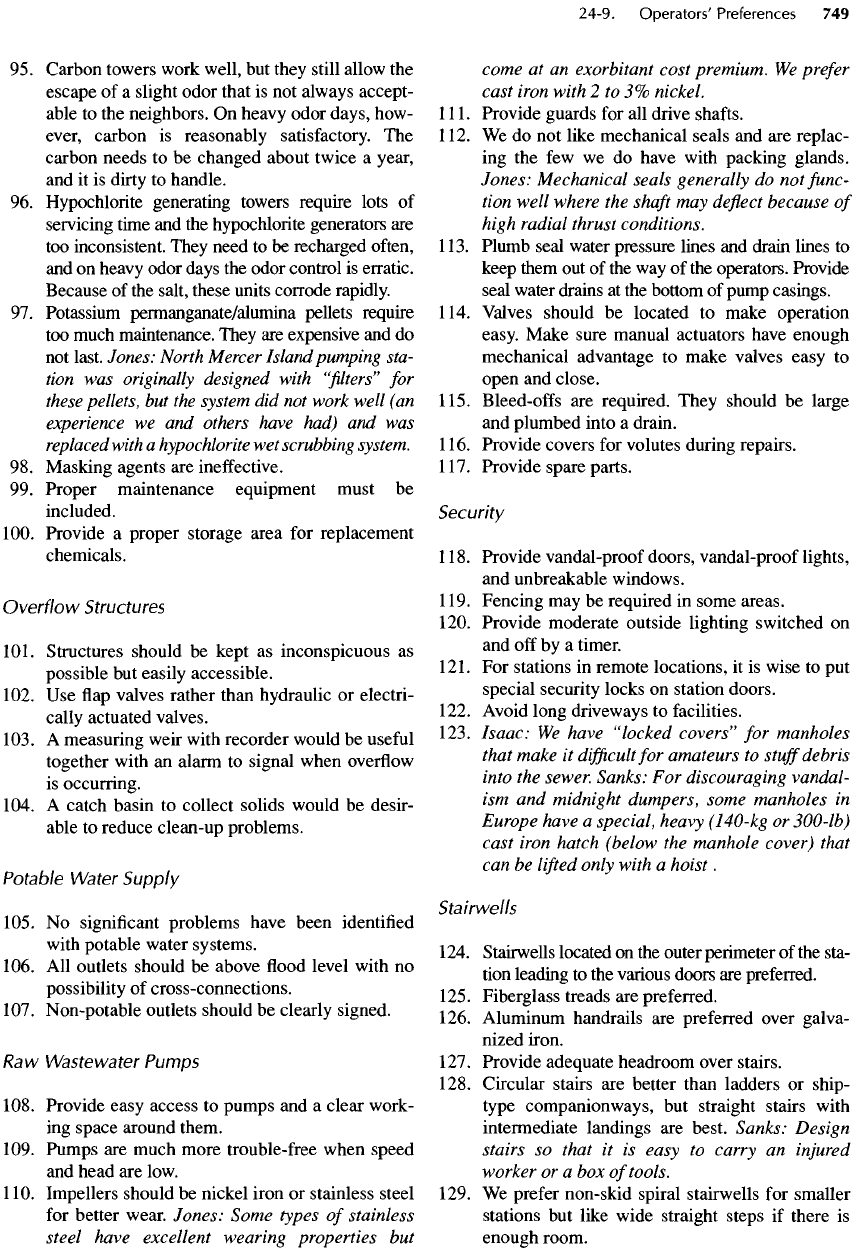
95.
Carbon towers work well,
but
they still allow
the
escape
of a
slight odor that
is not
always accept-
able
to the
neighbors.
On
heavy
odor
days, how-
ever,
carbon
is
reasonably satisfactory.
The
carbon needs
to be
changed about twice
a
year,
and
it is
dirty
to
handle.
96.
Hypochlorite
generating towers require lots
of
servicing
time
and the
hypochlorite
generators
are
too
inconsistent. They need
to be
recharged
often,
and
on
heavy odor days
the
odor control
is
erratic.
Because
of the
salt, these units corrode rapidly.
97.
Potassium permanganate/alumina pellets require
too
much maintenance. They
are
expensive
and do
not
last. Jones: North
Mercer
Island
pumping
sta-
tion
was
originally
designed
with
''filters"
for
these
pellets,
but the
system
did not
work
well
(an
experience
we and
others
have
had)
and was
replaced
with
a
hypochlorite
wet
scrubbing
system.
98.
Masking agents
are
ineffective.
99.
Proper maintenance equipment must
be
included.
100. Provide
a
proper storage area
for
replacement
chemicals.
Overflow
Structures
101.
Structures should
be
kept
as
inconspicuous
as
possible
but
easily
accessible.
102.
Use flap
valves rather than hydraulic
or
electri-
cally actuated valves.
103.
A
measuring weir with recorder would
be
useful
together with
an
alarm
to
signal when
overflow
is
occurring.
104.
A
catch basin
to
collect solids would
be
desir-
able
to
reduce clean-up problems.
Potable
Water
Supply
105.
No
significant problems have been identified
with
potable water systems.
106.
All
outlets should
be
above
flood
level with
no
possibility
of
cross-connections.
107. Non-potable outlets should
be
clearly signed.
Raw
Wastewater
Pumps
108. Provide easy access
to
pumps
and a
clear work-
ing
space around them.
109. Pumps
are
much more trouble-free when speed
and
head
are
low.
110.
Impellers should
be
nickel iron
or
stainless steel
for
better wear.
Jones:
Some
types
of
stainless
steel
have excellent wearing properties
but
come
at an
exorbitant cost premium.
We
prefer
cast
iron with
2 to 3%
nickel.
111.
Provide guards
for all
drive
shafts.
112.
We do not
like mechanical seals
and are
replac-
ing the few we do
have with packing glands.
Jones: Mechanical seals generally
do not
func-
tion
well where
the
shaft
may
deflect
because
of
high
radial thrust conditions.
113.
Plumb seal water pressure lines
and
drain lines
to
keep them
out of the way of the
operators. Provide
seal water drains
at the
bottom
of
pump casings.
114.
Valves should
be
located
to
make operation
easy. Make sure manual actuators have enough
mechanical advantage
to
make valves easy
to
open
and
close.
115.
Bleed-off
s
are
required. They should
be
large
and
plumbed into
a
drain.
116.
Provide covers
for
volutes during repairs.
117.
Provide spare
parts
.
Security
118.
Provide vandal-proof
doors
,
vandal-proof
lights
,
and
unbreakable windows.
119.
Fencing
may be
required
in
some areas.
120. Provide moderate outside lighting switched
on
and off by a
timer.
121.
For
stations
in
remote locations,
it is
wise
to put
special security locks
on
station doors.
122. Avoid long driveways
to
facilities.
123. Isaac:
We
have "locked covers"
for
manholes
that
make
it
difficult
for
amateurs
to
stuff
debris
into
the
sewer.
Sanks:
For
discouraging vandal-
ism and
midnight dumpers, some manholes
in
Europe
have
a
special,
heavy
(140-kg
or
300-lb)
cast
iron hatch (below
the
manhole cover) that
can be
lifted
only
with
a
hoist
.
Stairwells
124. Stairwells located
on the
outer perimeter
of the
sta-
tion leading
to the
various doors
are
preferred.
125.
Fiberglass treads
are
preferred.
126. Aluminum handrails
are
preferred over galva-
nized
iron.
127.
Provide adequate headroom over stairs.
128. Circular stairs
are
better
than
ladders
or
ship-
type companion
way
s, but
straight stairs with
intermediate landings
are
best. Sanks: Design
stairs
so
that
it is
easy
to
carry
an
injured
worker
or a box
of
tools.
129.
We
prefer non-skid spiral stairwells
for
smaller
stations
but
like wide straight steps
if
there
is
enough room.
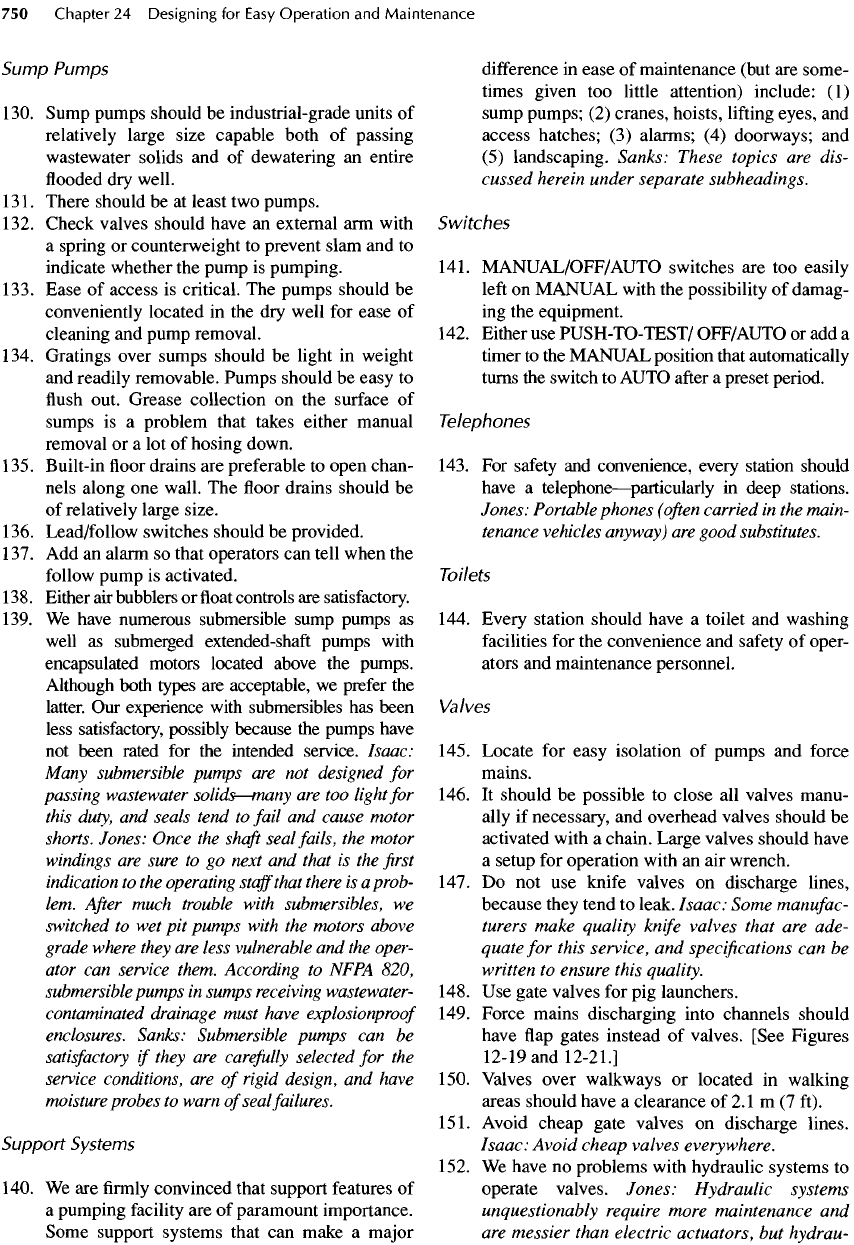
Sump
Pumps
130. Sump pumps should
be
industrial-grade units
of
relatively
large size capable both
of
passing
wastewater solids
and of
dewatering
an
entire
flooded
dry
well.
131.
There should
be at
least
two
pumps.
132. Check valves should have
an
external
arm
with
a
spring
or
counterweight
to
prevent slam
and to
indicate whether
the
pump
is
pumping.
133.
Ease
of
access
is
critical.
The
pumps should
be
conveniently located
in the dry
well
for
ease
of
cleaning
and
pump removal.
134. Gratings over sumps should
be
light
in
weight
and
readily removable. Pumps should
be
easy
to
flush
out.
Grease
collection
on the
surface
of
sumps
is a
problem that takes either manual
removal
or a lot of
hosing down.
135.
Built-in
floor
drains
are
preferable
to
open chan-
nels
along
one
wall.
The floor
drains should
be
of
relatively large size.
136. Lead/follow switches should
be
provided.
137.
Add an
alarm
so
that operators
can
tell when
the
follow
pump
is
activated.
138.
Either
air
bubblers
or float
controls
are
satisfactory.
139.
We
have numerous submersible sump pumps
as
well
as
submerged extended-shaft pumps with
encapsulated
motors located above
the
pumps.
Although
both types
are
acceptable,
we
prefer
the
latter.
Our
experience with submersibles
has
been
less satisfactory, possibly because
the
pumps have
not
been rated
for the
intended service. Isaac:
Many
submersible pumps
are not
designed
for
passing
wastewater
solids
—
many
are too
light
for
this
duty,
and
seals
tend
to
fail
and
cause motor
shorts.
Jones: Once
the
shaft
seal
fails,
the
motor
windings
are
sure
to go
next
and
that
is the first
indication
to the
operating
staff
that
there
is a
prob-
lem.
After
much
trouble
with submersibles,
we
switched
to wet pit
pumps with
the
motors above
grade
where
they
are
less
vulnerable
and the
oper-
ator
can
service them. According
to
NFPA
820,
submersible
pumps
in
sumps
receiving
wastewater-
contaminated
drainage
must have
explosionproof
enclosures.
Sanks:
Submersible pumps
can be
satisfactory
if
they
are
carefully
selected
for the
service
conditions,
are of
rigid
design,
and
have
moisture
probes
to
warn
of
seal
failures.
Support
Systems
140.
We are firmly
convinced that support features
of
a
pumping
facility
are of
paramount importance.
Some support systems that
can
make
a
major
difference
in
ease
of
maintenance (but
are
some-
times given
too
little attention) include:
(1)
sump
pumps;
(2)
cranes, hoists,
lifting
eyes,
and
access hatches;
(3)
alarms;
(4)
doorways;
and
(5)
landscaping. Sanks: These topics
are
dis-
cussed
herein under separate subheadings.
Switches
141. MANUAL/OFF/AUTO switches
are too
easily
left
on
MANUAL with
the
possibility
of
damag-
ing the
equipment.
142. Either
use
PUSH-TO-TEST/
OFF/AUTO
or add a
timer
to the
MANUAL position that automatically
turns
the
switch
to
AUTO
after
a
preset period.
Telephones
143.
For
safety
and
convenience, every station should
have
a
telephone
—
particularly
in
deep stations.
Jones:
Portable phones
(often
carried
in the
main-
tenance
vehicles
anyway)
are
good substitutes.
Toilets
144. Every station should have
a
toilet
and
washing
facilities
for the
convenience
and
safety
of
oper-
ators
and
maintenance personnel.
Valves
145. Locate
for
easy isolation
of
pumps
and
force
mains.
146.
It
should
be
possible
to
close
all
valves manu-
ally
if
necessary,
and
overhead valves should
be
activated with
a
chain.
Large valves should have
a
setup
for
operation with
an air
wrench.
147.
Do not use
knife valves
on
discharge lines,
because they tend
to
leak. Isaac: Some
manufac-
turers
make quality
knife
valves that
are
ade-
quate
for
this service,
and
specifications
can be
written
to
ensure this quality.
148.
Use
gate valves
for pig
launchers.
149.
Force
mains discharging
into
channels should
have
flap
gates instead
of
valves. [See Figures
12-19
and
12-21.]
150. Valves over walkways
or
located
in
walking
areas should have
a
clearance
of
2.1
m (7
ft).
151.
Avoid cheap gate valves
on
discharge lines.
Isaac: Avoid cheap valves everywhere.
152.
We
have
no
problems with hydraulic systems
to
operate valves. Jones: Hydraulic systems
unquestionably
require more maintenance
and
are
messier than electric
actuators,
but
hydrau-

lie
actuators
are
better
for
protection against
hydraulic
transient conditions
and flooding.
Variable-Speed
(V/S)
versus
Constant
Speed
(C/S)
Pumps
153.
Variable-
speed
pumps
are
preferred
and
seem
to
do a
better
job of
keeping
the wet
well
clean.
154.
Our
types
of V/S
drives include liquid rheo-
stats,
eddy-current couplings,
and
adjustable-
frequency
drives (AFDs).
All
have been satis-
factory,
but
each
has
shortcomings.
155. Liquid rheostats
are
relatively slow
in
response
to wet
well level changes. They have more main-
tenance problems. They
can
become fouled
by
electrolyte leaks. Changing electrolyte should
be
done with care
and
only
by
trained technicians.
156. Eddy-current couplings
are the
most mainte-
nance-free
system
in
use. They
run
well with
very
few
problems
and
have proven
to be
very
reliable.
But we
have
had
difficulty
recently
in
obtaining parts
from
certain manufacturers
who
no
longer build them
in the
smaller sizes,
56 to
112kW(75tol50hp).
157. AFDs
are
quick
in
response,
but
they
are
subject
to
nuisance shutdown
from
small changes
in
incoming line voltage.
All of
ours
are
sensitive
to
voltage dips. Overheating
is a
problem.
In
general, AFDs give more trouble than other
types
of
variable-
speed
drives.
Sanks:
AFDs
have
recently
become more versatile
and
robust.
Automatic restart with power line synchroniza-
tion
is
obtainable
and
should always
be
speci-
fied.
Some drives
now
produce
a
nearly
perfect
sine
wave without
the
spikes that cause heating.
The
overheating problem
at low
speed
can be
solved
by
adding
a fan
driven
by a
small motor
directly
connected
to 60 Hz, ac
power.
158.
The
control system must
be
tailored
for the
application
and flowrate.
Ventilation
159. Good ventilation
is
very important
for
both
equipment
and
operators.
160.
No
less than
10 air
changes
per
hour
(ac/h)
for dry
wells
and 20
ac/h
for wet
wells
is
required
to
pre-
vent
corrosion
and
odors. Jones:
We
recommend
10
ac/h
for
pump
rooms
and a
minimum
of
20
ac/h
for wet
wells
and
screen rooms
(40
ac/h
in
south-
ern
states
where
the
wastewater
is
warmer
and the
need
for
hydrogen
sulfide
production
is
greater).
161.
The
general design principle
of
using both inlet
and
exhaust
fans
to
introduce
air at the
ceiling
and
discharge
air
into ducts
at the floor has
been
effective
in
providing
a
pleasant work environ-
ment
and
protection
of the
equipment.
For
example, there
has
never been condensation
on
any
equipment
—
even
on
tanks. Sanks: Proper
ducting
is
just
as
important
as the
number
of
air
changes
per
hour.
162.
If the dry
well
is
vented
to the wet
well,
set up
the
duct work
so
that
a
high
wet-
well
level can-
not flood the dry
well.
A few
problems
in
early
designs were corrected
in
subsequent designs.
The dry
well
in the
Bellevue Pumping Station
was
flooded
shortly
after
being placed
in
ser-
vice. Power failure caused
a
high
wet
well level
and
allowed wastewater
to flow
through
a
venti-
lation duct between
the wet and dry
wells.
Jones:
Any
ducting whatsoever between
wet and
dry
wells
is now
prohibited
by
NFPA
820.
163. Sail switch alarms
in the
ventilation ductwork
systems were provided
in
many
of the
early sta-
tions
and
were subsequently connected
to the
main treatment plant control centers over leased
telemetry lines. These caused numerous nui-
sance calls
to
check stations that could have
been serviced during
the
next routine inspection.
164.
The
high
(10
to 20
ac/h)
air
exchange rates spec-
ified
in
early stations
has
created some
difficul-
ties when trying
to
retrofit
facilities with odor
control equipment. Replacing
fans
or
adjusting
sheave
sizes
has
largely
alleviated
this problem.
165.
If
exhaust gases must
be
scrubbed
for
odor con-
trol, high-volume ventilation becomes very
expensive. Jones:
This
consideration puts
the
engineer
at a
decided disadvantage.
Ventilation
at
lesser rates [than above] creates,
in
effect,
confined
spaces that require three-person
entry
teams
and
safety
equipment.
It
also exposes
the
engineer
to the
potential
for
liability claims
if
an
accident
occurs. Given
the
value placed
on
human
life,
the
added
expense
of an
odor con-
trol
system
for the
greater ventilation rates
seems
a
justifiable,
needed expense.
Wet
Wells
166.
The
long, narrow self-cleaning [trench-type]
pump intake basin works well
in
practice.
All of
our
future
pumping stations will
be of
this type.
167. Seattle
Metro's
wet
wells
are
pumped
and
hosed
down
at
least weekly
and
even more frequently
in
troublesome locations.
168.
The
older
"traditional"
wet
wells
for
constant-
speed (C/S) pumps were dangerously odiferous
and
huge piles
of
grit accumulated rapidly.
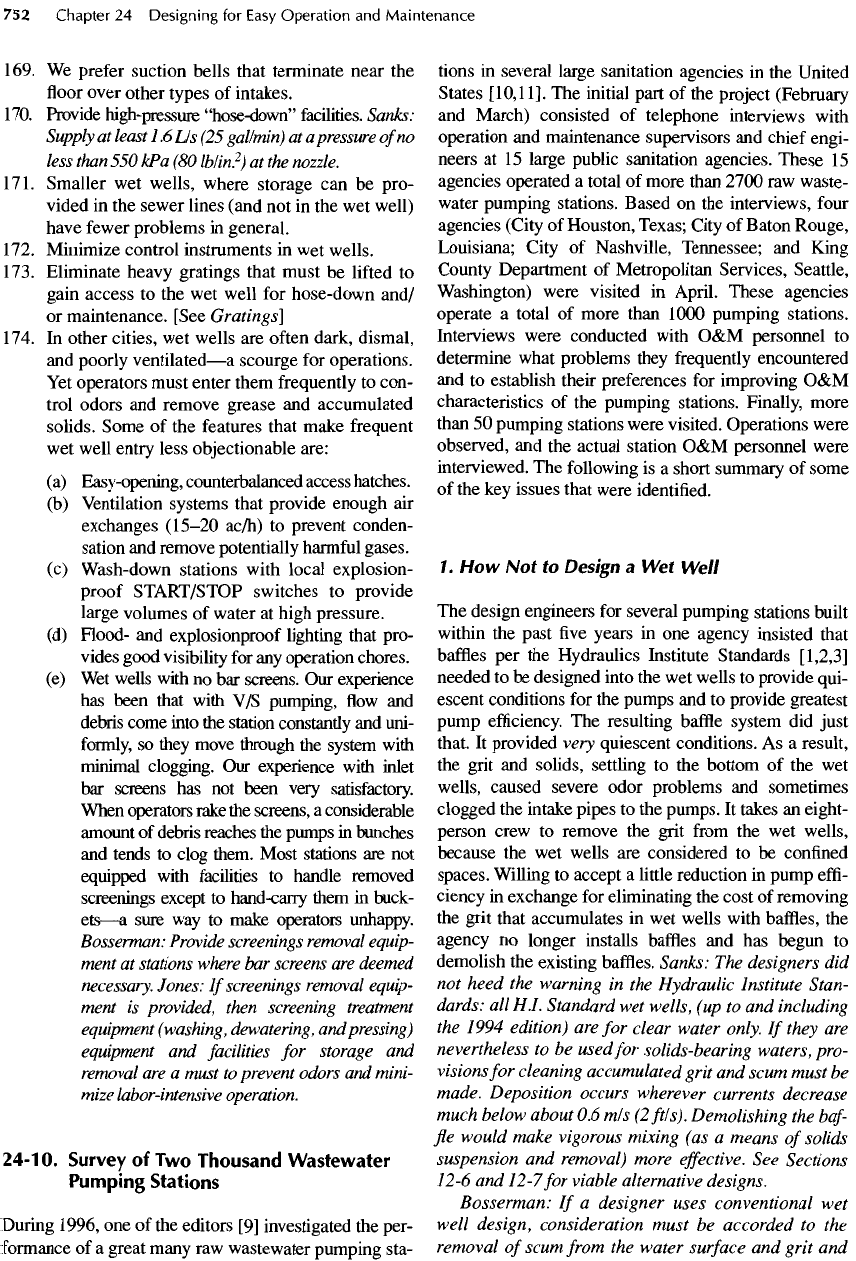
169.
We
prefer suction bells that terminate near
the
floor
over other types
of
intakes.
170. Provide high-pressure
"hose-down"
facilities.
Sanks:
Supply
at
least
1
.6
LIs (25
gallmin)
at a
pressure
of
no
less
than
550
kPa
(80
lblin?)
at the
nozzle.
111.
Smaller
wet
wells, where storage
can be
pro-
vided
in the
sewer lines (and
not in the wet
well)
have
fewer problems
in
general.
172. Minimize control instruments
in wet
wells.
173. Eliminate heavy gratings that must
be
lifted
to
gain access
to the wet
well
for
hose-down and/
or
maintenance. [See Gratings]
174.
In
other cities,
wet
wells
are
often
dark, dismal,
and
poorly
ventilated
—
a
scourge
for
operations.
Yet
operators must enter them frequently
to
con-
trol odors
and
remove
grease
and
accumulated
solids. Some
of the
features that make frequent
wet
well entry less objectionable are:
(a)
Easy-opening, counterbalanced access
hatches,
(b)
Ventilation systems that provide enough
air
exchanges
(15-20
ac/h)
to
prevent conden-
sation
and
remove potentially
harmful
gases,
(c)
Wash-down stations with
local
explosion-
proof START/STOP switches
to
provide
large volumes
of
water
at
high
pressure,
(d)
Rood-
and
explosionproof lighting that pro-
vides good visibility
for any
operation
chores,
(e)
Wet
wells with
no bar
screens.
Our
experience
has
been that with
V/S
pumping,
flow and
debris
come into
the
station constantly
and
uni-
formly,
so
they move through
the
system with
minimal
clogging.
Our
experience
with
inlet
bar
screens
has not
been very satisfactory.
When operators rake
the
screens,
a
considerable
amount
of
debris reaches
the
pumps
in
bunches
and
tends
to
clog them. Most stations
are not
equipped with facilities
to
handle removed
screenings except
to
hand-carry them
in
buck-
ets
—
a
sure
way to
make operators unhappy.
Bosserman:
Provide
screenings
removal
equip-
ment
at
stations
where
bar
screens
are
deemed
necessary.
Jones:
If
screenings
removal
equip-
ment
is
provided,
then
screening
treatment
equipment
(washing,
dewatering,
and
pressing)
equipment
and
facilities
for
storage
and
removal
are a
must
to
prevent
odors
and
mini-
mize
labor-intensive
operation.
24-10.
Survey
of Two
Thousand
Wastewater
Pumping
Stations
During 1996,
one of the
editors
[9]
investigated
the
per-
formance
of a
great many
raw
wastewater pumping sta-
tions
in
several large sanitation agencies
in the
United
States
[10,11].
The
initial part
of the
project (February
and
March) consisted
of
telephone interviews with
operation
and
maintenance supervisors
and
chief engi-
neers
at 15
large public sanitation agencies.
These
15
agencies operated
a
total
of
more than
2700
raw
waste-
water pumping stations. Based
on the
interviews,
four
agencies (City
of
Houston, Texas; City
of
Baton Rouge,
Louisiana; City
of
Nashville, Tennessee;
and
King
County
Department
of
Metropolitan Services, Seattle,
Washington) were visited
in
April.
These
agencies
operate
a
total
of
more than 1000 pumping stations.
Interviews were conducted with
O&M
personnel
to
determine what problems they frequently encountered
and
to
establish their preferences
for
improving
O&M
characteristics
of the
pumping stations. Finally, more
than
50
pumping stations were visited. Operations were
observed,
and the
actual station
O&M
personnel were
interviewed.
The
following
is a
short summary
of
some
of
the key
issues that were identified.
1.
How Not to
Design
a Wet
Well
The
design engineers
for
several pumping stations built
within
the
past
five
years
in one
agency insisted that
baffles
per the
Hydraulics Institute Standards
[1,2,3]
needed
to be
designed into
the wet
wells
to
provide qui-
escent conditions
for the
pumps
and to
provide greatest
pump
efficiency.
The
resulting
baffle
system
did
just
that.
It
provided
very
quiescent conditions.
As a
result,
the
grit
and
solids, settling
to the
bottom
of the wet
wells, caused severe odor problems
and
sometimes
clogged
the
intake
pipes
to the
pumps.
It
takes
an
eight-
person crew
to
remove
the
grit
from
the wet
wells,
because
the wet
wells
are
considered
to be
confined
spaces.
Willing
to
accept
a
little
reduction
in
pump
effi-
ciency
in
exchange
for
eliminating
the
cost
of
removing
the
grit that accumulates
in wet
wells with
baffles,
the
agency
no
longer installs
baffles
and has
begun
to
demolish
the
existing
baffles.
Sanks:
The
designers
did
not
heed
the
warning
in the
Hydraulic
Institute Stan-
dards:
all HJ.
Standard
wet
wells,
(up to and
including
the
1994 edition)
are for
clear water
only.
If
they
are
nevertheless
to be
used
for
solids-bearing waters, pro-
visions
for
cleaning accumulated grit
and
scum must
be
made.
Deposition occurs wherever currents decrease
much
below about
0.6
mis
(2ft/s).
Demolishing
the
baf-
fle
would
make vigorous mixing
(as a
means
of
solids
suspension
and
removal)
more
effective.
See
Sections
12-6
and
12-7
for
viable alternative designs.
Bosserman:
If a
designer uses conventional
wet
well
design, consideration must
be
accorded
to the
removal
of
scum from
the
water
surface
and
grit
and

other settleable solids from
the
bottom
of the
sump.
Unfortunately,
only
recently
(with
some exceptions)
have
designers
and
published design
standards
or
guidelines giving this factor
the
serious consideration
that
it
deserves. Access must
be
convenient
for
bring-
ing
in
cleaning equipment such
as
hoses
to
"wash
grease
off
the
sump
walls
and
vacuum hoses
or
other
means
to
remove
the
accumulated sediments.
The wet
well
walls
and
ceiling should
be
lined with smooth
PVC
to
prevent
the
attack
on
concrete
by
sulfuric
acid
(derived
from hydrogen
sulfide)
above
the
water line
and to
make
it
easy
to
wash grease
off
the
walls. Grat-
ings, sidewalks,
or
landings that
do not
interfere
with
hoses
should
be
provided
for the
convenience
of the
cleaning
crews.
2.
More
Comments
on Wet
Well
Design
The
vast majority
of the dry
well pumping stations
in
these agencies have sealed
wet
wells without ventila-
tion. They contain
a
"breather"
vent pipe, typically
150 mm (6
in.)
in
diameter, coming
out of the wet
well roof. When
O&M
personnel have
to
enter
the wet
wells (which
is not
very often), they
use
portable
blowers
and
ducting
to
supply
the
necessary ventila-
tion.
In the
latest designs,
the wet
wells
are
lined with
PVC.
One
agency (King County Department
of
Met-
ropolitan Services) that does desire routine
and
conve-
nient personnel access
to the wet
well used
the
following
design
in
their most
recent
pumping station
(Interurban),
started
up in
March,
1996:
(a)
A
catwalk
of FRP
grating over
the
entire length
of
the wet
well about
0.6 m (2 ft)
above
the
high-water
level),
so
that
personnel
can
walk
over
the
entire
wet
well.
The
clearance
between
the
catwalk
and the
walls
is
about
0.3
m (1 ft) to
permit unobstructed wash-down
of
the
walls,
(b)
Variable-speed pumping,
so
that
the wet
well water level does
not fluctuate
very
much.
(c)
Explosionproof (NEMA
7)
lighting fix-
tures,
accessible
from
the
grating
for
replacement,
(d)
Walls
and
ceiling
are
lined with PVC.
(e)
No
screens
or
grinders,
(f)
The
ventilation system
is so
effective
(the
editor entered
the wet
well) that there
was
hardly
any
"sewage"
odor,
in
spite
of the
fact
that
raw
wastewater
was
just
2 ft
below
the
grating. There
are
several ventilation
ducts with
diffusers
on
each,
to
distribute
the air
into
the wet
well.
3.
Example
of
Unwarranted
Optimism
in the
Design
Engineer
A
consulting engineering
firm
decided
to use
close-
coupled vertical wastewater pumps, because
the wet
well
was of a
design that could
not
possibly
be
flooded.
There
was a
solid, unpierced concrete wall
between
the wet
well
and the dry
well
from
the
bot-
tom
slab
of the
structure
all the way up to the
roof slab
of
the dry
well containing
the
pumps.
The
following
sequence
of
events occurred
one
day:
(a)
There
was a
storm, during which
a
power
fail-
ure
occurred,
(b)
In
accordance with Murphy's
Law
("If any-
thing
can go
wrong,
it
will"),
the
standby
engine generator failed
to
start.
(c)
There
was a
rest room with
a
toilet
on the
roof slab over
the dry
well.
The
toilet
was
connected
via a
pipe
to the wet
well. There
was
no
check valve
in the
pipe.
The
waste-
water backed
up in the wet
well,
flowed up
the
pipe, over
the
toilet, across
the floor,
and
down
the
stairway into
the dry
well that
couldn't
be flooded.
4.
Maintaining
Dry Pit
Pumps
versus
Submersible
Pumps
All
the O&M
personnel
at all the
agencies
visited
felt
that
it is
much easier
to
maintain
a dry pit
pump,
unless
the
submersible pump
was
manufactured
by
one
specific manufacturer. This
one
manufacturer
(a
large corporation)
was
almost unanimously acclaimed
as
having
the
most
reliable
pump
on the
market, with
O&M
requirements that were comparable
to
those
for
conventional
dry pit
pumps.
Three
other manufactur-
ers
were frequently cited
as
providing good pumps,
although
not
quite
as
good
as
Manufacturer
No.
1.
(a)
Their main reason
for
stating that
it is
much
easier
to
maintain
a dry pit
pump
is
that with
a dry pit
pump,
the O&M
staff
can
inspect
it
and
tell when something
is
amiss
and
repair
it
before
the
problem becomes
too
serious.
Such inspection
is
impossible with sub-
mersible pumps, because they cannot
be
observed routinely
and
must
be
hauled
out
of
the wet
well
for
repairs. Consequently,
there
is a
greater tendency
to let the
sub-
mersible pump
run
until
it
simply
fails.
Then
the
cost
of
repair
is
usually very
high,
(b)
Submersible pumps
are
quite variable
in
fre-
quency
of
maintenance required. Some
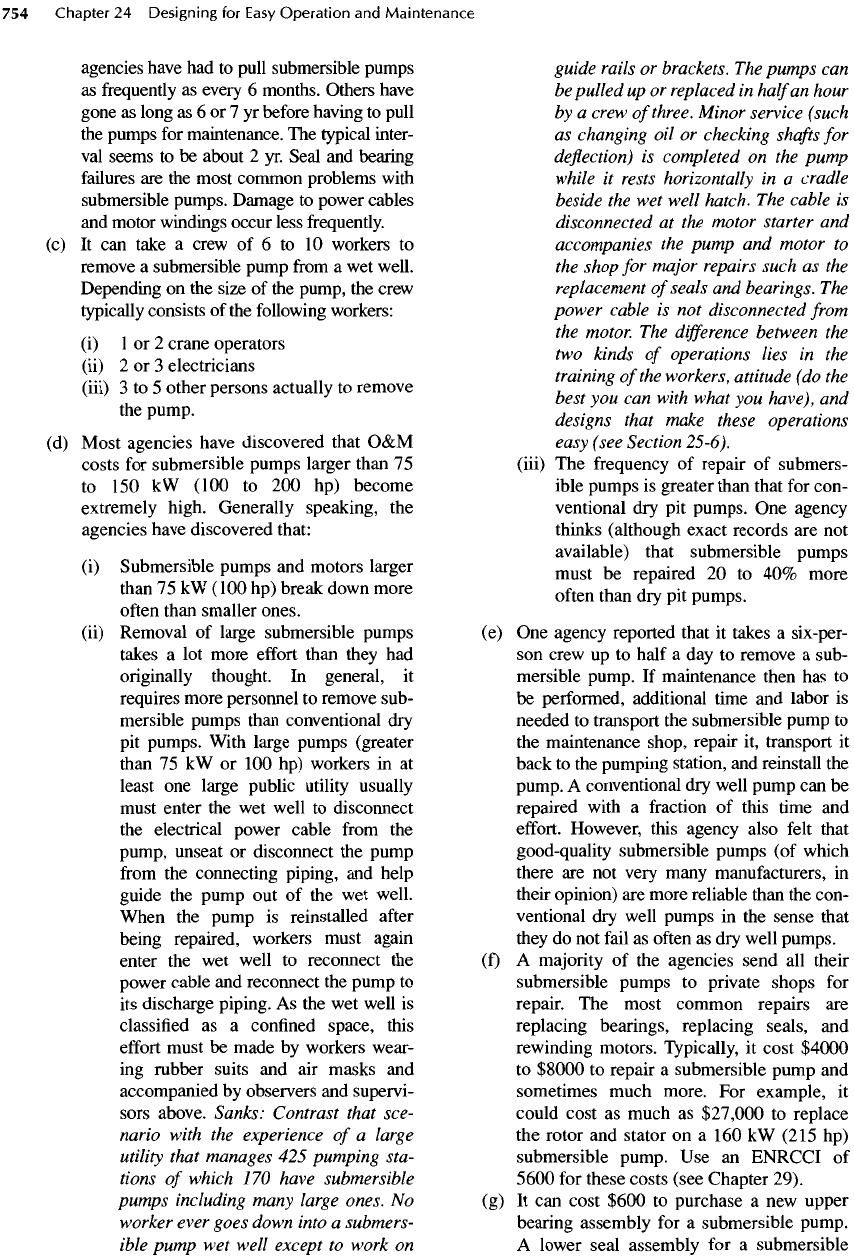
agencies have
had to
pull submersible pumps
as
frequently
as
every
6
months. Others have
gone
as
long
as 6 or 7 yr
before having
to
pull
the
pumps
for
maintenance.
The
typical inter-
val
seems
to be
about
2 yr.
Seal
and
bearing
failures
are the
most common problems with
submersible pumps. Damage
to
power cables
and
motor windings occur less frequently.
(c)
It can
take
a
crew
of 6 to 10
workers
to
remove
a
submersible pump
from
a wet
well.
Depending
on the
size
of the
pump,
the
crew
typically
consists
of the
following workers:
(i)
1 or 2
crane operators
(ii)
2 or 3
electricians
(iii)
3 to 5
other
persons
actually
to
remove
the
pump.
(d)
Most agencies have discovered that
O&M
costs
for
submersible pumps larger than
75
to
150 kW
(100
to 200 hp)
become
extremely high. Generally speaking,
the
agencies have discovered that:
(i)
Submersible pumps
and
motors larger
than
75
kW
(100
hp)
break down more
often
than smaller
ones,
(ii)
Removal
of
large submersible pumps
takes
a lot
more
effort
than they
had
originally thought.
In
general,
it
requires more personnel
to
remove sub-
mersible pumps than conventional
dry
pit
pumps. With large pumps (greater
than
75 kW or 100 hp)
workers
in at
least
one
large public utility usually
must
enter
the wet
well
to
disconnect
the
electrical power cable
from
the
pump,
unseat
or
disconnect
the
pump
from
the
connecting piping,
and
help
guide
the
pump
out of the wet
well.
When
the
pump
is
reinstalled
after
being repaired, workers must again
enter
the wet
well
to
reconnect
the
power cable
and
reconnect
the
pump
to
its
discharge piping.
As the wet
well
is
classified
as a
confined space, this
effort
must
be
made
by
workers wear-
ing
rubber suits
and air
masks
and
accompanied
by
observers
and
supervi-
sors above.
Sanks:
Contrast that sce-
nario
with
the
experience
of a
large
utility
that manages
425
pumping sta-
tions
of
which
170
have submersible
pumps including many
large
ones.
No
worker
ever goes down into
a
submers-
ible
pump
wet
well
except
to
work
on
guide
rails
or
brackets.
The
pumps
can
be
pulled
up or
replaced
in
half
an
hour
by
a
crew
of
three. Minor service
(such
as
changing
oil or
checking
shafts
for
deflection)
is
completed
on the
pump
while
it
rests
horizontally
in a
cradle
beside
the wet
well hatch.
The
cable
is
disconnected
at the
motor starter
and
accompanies
the
pump
and
motor
to
the
shop
for
major
repairs
such
as the
replacement
of
seals
and
bearings.
The
power cable
is not
disconnected from
the
motor.
The
difference
between
the
two
kinds
of
operations lies
in the
training
of
the
workers, attitude
(do the
best
you can
with what
you
have),
and
designs
that make these operations
easy
(see Section 25-6).
(iii)
The
frequency
of
repair
of
submers-
ible pumps
is
greater than that
for
con-
ventional
dry pit
pumps.
One
agency
thinks (although exact records
are not
available) that submersible pumps
must
be
repaired
20 to 40%
more
often
than
dry pit
pumps.
(e)
One
agency reported that
it
takes
a
six-per-
son
crew
up to
half
a day to
remove
a
sub-
mersible pump.
If
maintenance then
has to
be
performed, additional time
and
labor
is
needed
to
transport
the
submersible pump
to
the
maintenance shop,
repair
it,
transport
it
back
to the
pumping station,
and
reinstall
the
pump.
A
conventional
dry
well pump
can be
repaired with
a
fraction
of
this time
and
effort.
However, this agency also
felt
that
good-quality submersible pumps
(of
which
there
are not
very many manufacturers,
in
their opinion)
are
more reliable than
the
con-
ventional
dry
well pumps
in the
sense that
they
do not
fail
as
often
as dry
well
pumps,
(f)
A
majority
of the
agencies send
all
their
submersible pumps
to
private shops
for
repair.
The
most common repairs
are
replacing bearings, replacing seals,
and
rewinding motors. Typically,
it
cost
$4000
to
$8000
to
repair
a
submersible pump
and
sometimes much more.
For
example,
it
could cost
as
much
as
$27,000
to
replace
the
rotor
and
stator
on a 160 kW
(215
hp)
submersible pump.
Use an
ENRCCI
of
5600
for
these
costs
(see Chapter 29).
(g)
It can
cost
$600
to
purchase
a new
upper
bearing assembly
for a
submersible pump.
A
lower
seal
assembly
for a
submersible
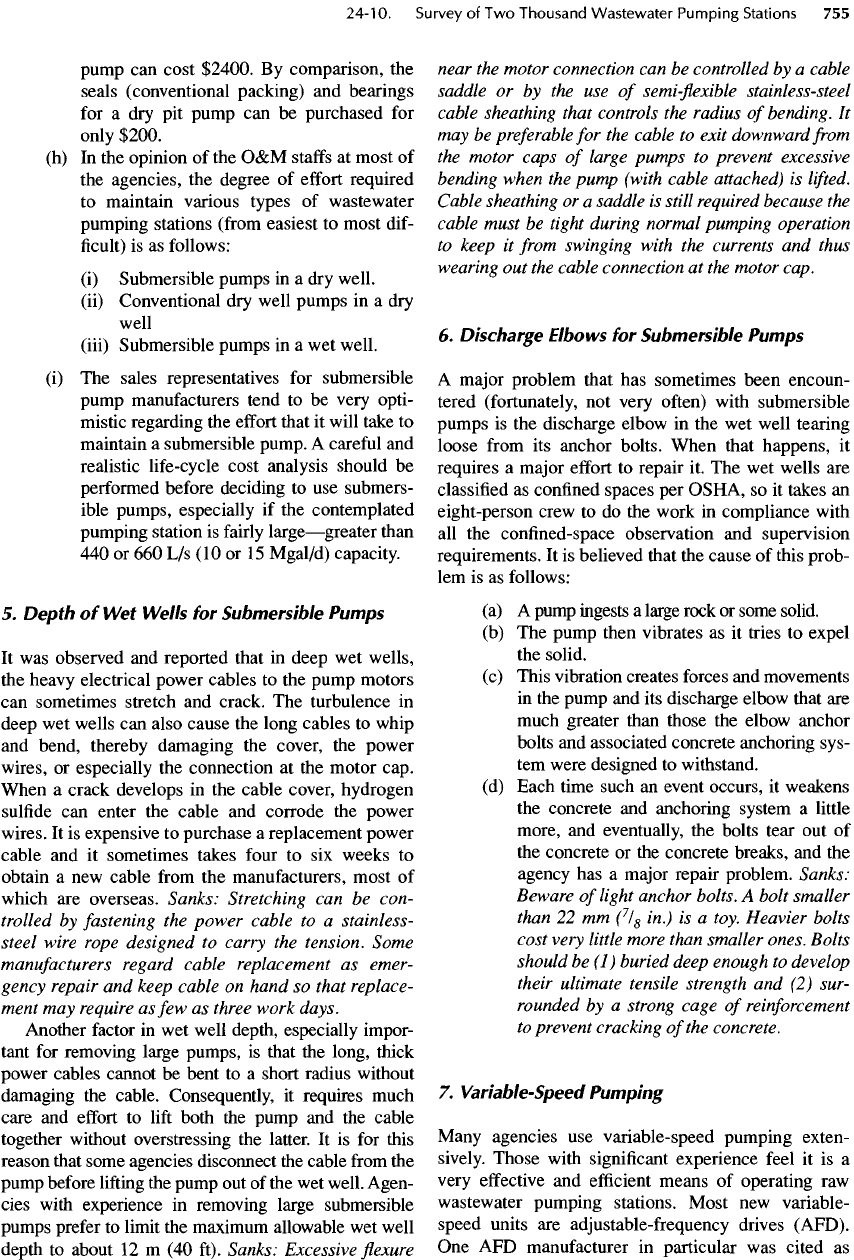
pump
can
cost
$2400.
By
comparison,
the
seals
(conventional packing)
and
bearings
for
a dry pit
pump
can be
purchased
for
only
$200.
(h) In the
opinion
of the O&M
staffs
at
most
of
the
agencies,
the
degree
of
effort
required
to
maintain various types
of
wastewater
pumping
stations
(from
easiest
to
most dif-
ficult)
is
as
follows:
(i)
Submersible pumps
in a dry
well,
(ii) Conventional
dry
well pumps
in a dry
well
(iii) Submersible pumps
in a wet
well.
(i)
The
sales representatives
for
submersible
pump
manufacturers tend
to be
very opti-
mistic regarding
the
effort
that
it
will take
to
maintain
a
submersible pump.
A
careful
and
realistic life-cycle cost analysis should
be
performed
before deciding
to use
submers-
ible pumps, especially
if the
contemplated
pumping station
is
fairly
large
—
greater
than
440 or 660 L/s (10 or 15
Mgal/d)
capacity.
5.
Depth
of Wet
Wells
for
Submersible Pumps
It
was
observed
and
reported that
in
deep
wet
wells,
the
heavy electrical power cables
to the
pump motors
can
sometimes stretch
and
crack.
The
turbulence
in
deep
wet
wells
can
also cause
the
long cables
to
whip
and
bend, thereby damaging
the
cover,
the
power
wires,
or
especially
the
connection
at the
motor cap.
When
a
crack develops
in the
cable cover, hydrogen
sulfide
can
enter
the
cable
and
corrode
the
power
wires.
It is
expensive
to
purchase
a
replacement power
cable
and it
sometimes takes
four
to six
weeks
to
obtain
a new
cable
from
the
manufacturers, most
of
which
are
overseas.
Sanks:
Stretching
can be
con-
trolled
by
fastening
the
power cable
to a
stainless-
steel
wire
rope
designed
to
carry
the
tension. Some
manufacturers
regard cable replacement
as
emer-
gency
repair
and
keep
cable
on
hand
so
that replace-
ment
may
require
as
few
as
three work days.
Another factor
in wet
well depth, especially impor-
tant
for
removing large pumps,
is
that
the
long, thick
power cables cannot
be
bent
to a
short radius without
damaging
the
cable. Consequently,
it
requires much
care
and
effort
to
lift
both
the
pump
and the
cable
together without overstressing
the
latter.
It is for
this
reason that some agencies disconnect
the
cable
from
the
pump
before
lifting
the
pump
out of the wet
well. Agen-
cies with experience
in
removing large submersible
pumps
prefer
to
limit
the
maximum allowable
wet
well
depth
to
about
12m
(40
ft). Sanks: Excessive
flexure
near
the
motor connection
can be
controlled
by a
cable
saddle
or by the use of
semi-flexible
stainless-steel
cable
sheathing that controls
the
radius
of
bending.
It
may
be
preferable
for the
cable
to
exit
downward
from
the
motor
caps
of
large
pumps
to
prevent excessive
bending
when
the
pump
(with
cable
attached)
is
lifted.
Cable
sheathing
or a
saddle
is
still
required
because
the
cable
must
be
tight during normal pumping operation
to
keep
it
from swinging with
the
currents
and
thus
wearing
out the
cable connection
at the
motor cap.
6.
Discharge Elbows
for
Submersible Pumps
A
major problem that
has
sometimes been encoun-
tered (fortunately,
not
very often) with submersible
pumps
is the
discharge elbow
in the wet
well tearing
loose
from
its
anchor
bolts.
When that happens,
it
requires
a
major
effort
to
repair
it. The wet
wells
are
classified
as
confined spaces
per
OSHA,
so it
takes
an
eight-person crew
to do the
work
in
compliance with
all the
confined-
space
observation
and
supervision
requirements.
It is
believed that
the
cause
of
this prob-
lem is as
follows:
(a)
A
pump ingests
a
large rock
or
some
solid,
(b)
The
pump then vibrates
as it
tries
to
expel
the
solid.
(c)
This vibration creates forces
and
movements
in
the
pump
and its
discharge elbow that
are
much
greater than those
the
elbow anchor
bolts
and
associated concrete anchoring sys-
tem
were designed
to
withstand,
(d)
Each time such
an
event occurs,
it
weakens
the
concrete
and
anchoring system
a
little
more,
and
eventually,
the
bolts tear
out of
the
concrete
or the
concrete breaks,
and the
agency
has a
major repair problem. Sanks:
Beware
of
light anchor bolts.
A
bolt smaller
than
22 mm
(
7
I
8
in.)
is a
toy. Heavier bolts
cost
very
little more than smaller ones. Bolts
should
be
(1)
buried
deep
enough
to
develop
their
ultimate tensile strength
and (2)
sur-
rounded
by a
strong cage
of
reinforcement
to
prevent cracking
of
the
concrete.
7.
Variable-Speed
Pumping
Many agencies
use
variable-speed pumping exten-
sively. Those with significant experience feel
it is a
very effective
and
efficient
means
of
operating
raw
wastewater pumping stations. Most
new
variable-
speed units
are
adjustable-frequency drives (AFD).
One AFD
manufacturer
in
particular
was
cited
as
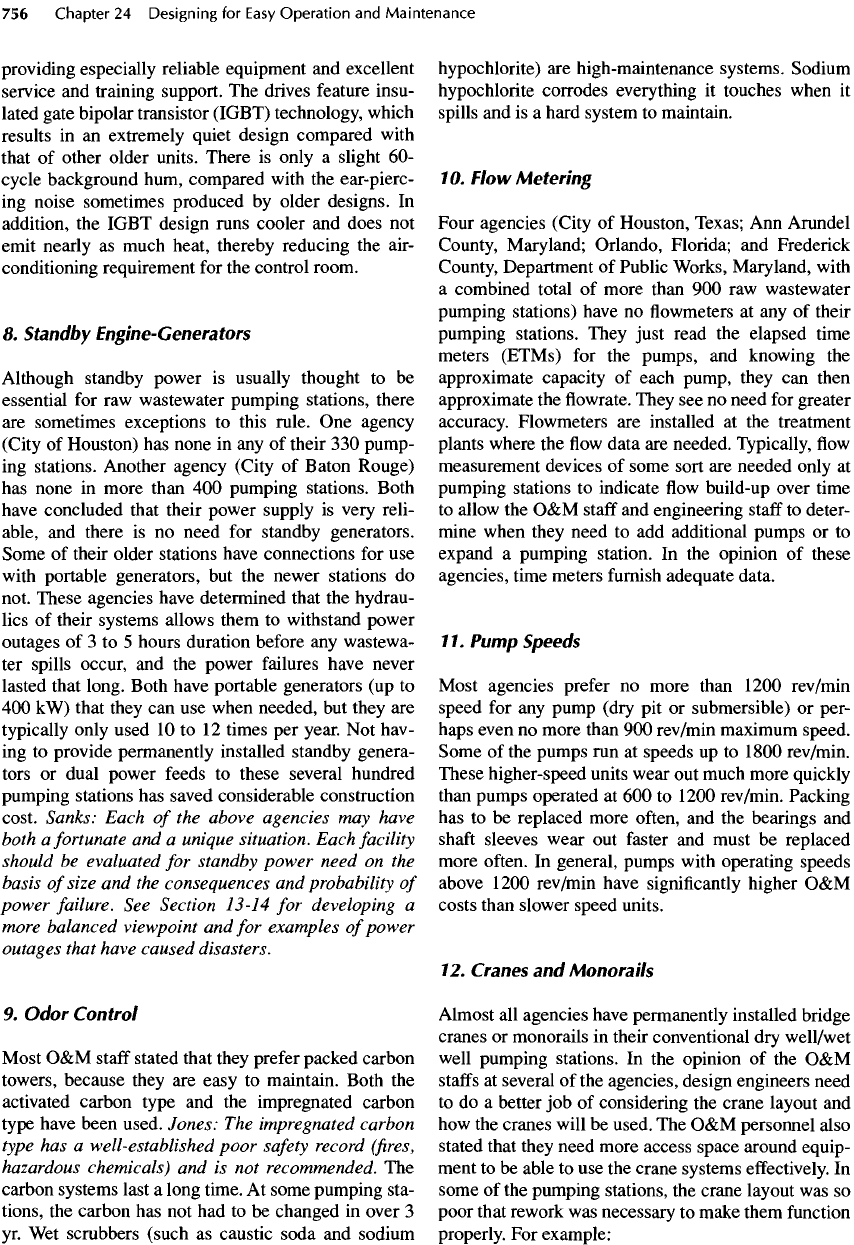
providing
especially
reliable
equipment
and
excellent
service
and
training support.
The
drives feature insu-
lated gate bipolar transistor (IGBT) technology, which
results
in an
extremely quiet design compared with
that
of
other older units. There
is
only
a
slight
60-
cycle
background hum, compared with
the
ear-pierc-
ing
noise sometimes produced
by
older designs.
In
addition,
the
IGBT design runs
cooler
and
does
not
emit nearly
as
much heat, thereby reducing
the
air-
conditioning requirement
for the
control room.
8.
Standby
Engine-Generators
Although
standby power
is
usually thought
to be
essential
for raw
wastewater pumping stations, there
are
sometimes exceptions
to
this rule.
One
agency
(City
of
Houston)
has
none
in any of
their
330
pump-
ing
stations. Another agency (City
of
Baton Rouge)
has
none
in
more than
400
pumping stations. Both
have
concluded that their power supply
is
very reli-
able,
and
there
is no
need
for
standby generators.
Some
of
their older stations have connections
for use
with
portable generators,
but the
newer stations
do
not. These agencies have determined that
the
hydrau-
lics
of
their systems allows them
to
withstand power
outages
of 3 to 5
hours duration before
any
wastewa-
ter
spills occur,
and the
power failures have never
lasted that long. Both have portable generators
(up to
400 kW)
that they
can use
when
needed,
but
they
are
typically
only used
10 to 12
times
per
year.
Not
hav-
ing
to
provide permanently installed standby genera-
tors
or
dual power feeds
to
these several hundred
pumping
stations
has
saved considerable construction
cost.
Sanks:
Each
of the
above agencies
may
have
both
a
fortunate
and a
unique situation. Each facility
should
be
evaluated
for
standby power need
on the
basis
of
size
and the
consequences
and
probability
of
power
failure.
See
Section
13-14
for
developing
a
more
balanced viewpoint
and for
examples
of
power
outages
that have caused disasters.
9.
Odor Control
Most
O&M
staff
stated that they prefer packed carbon
towers, because they
are
easy
to
maintain. Both
the
activated
carbon type
and the
impregnated carbon
type
have been used. Jones:
The
impregnated carbon
type
has a
well-established poor
safety
record
(fires,
hazardous
chemicals)
and is not
recommended.
The
carbon systems last
a
long time.
At
some pumping sta-
tions,
the
carbon
has not had to be
changed
in
over
3
yr.
Wet
scrubbers (such
as
caustic soda
and
sodium
hypochlorite)
are
high-maintenance
systems.
Sodium
hypochlorite corrodes everything
it
touches when
it
spills
and is a
hard system
to
maintain.
10.
Flow
Metering
Four
agencies
(City
of
Houston, Texas;
Ann
Arundel
County,
Maryland; Orlando, Florida;
and
Frederick
County,
Department
of
Public Works, Maryland, with
a
combined total
of
more than
900 raw
wastewater
pumping
stations) have
no flowmeters at any of
their
pumping
stations. They just read
the
elapsed time
meters (ETMs)
for the
pumps,
and
knowing
the
approximate capacity
of
each pump, they
can
then
approximate
the flowrate.
They
see no
need
for
greater
accuracy. Flowmeters
are
installed
at the
treatment
plants where
the flow
data
are
needed. Typically,
flow
measurement devices
of
some sort
are
needed only
at
pumping stations
to
indicate
flow
build-up over time
to
allow
the O&M
staff
and
engineering
staff
to
deter-
mine when they need
to add
additional pumps
or to
expand
a
pumping station.
In the
opinion
of
these
agencies, time meters
furnish
adequate data.
11.
Pump
Speeds
Most agencies prefer
no
more than 1200
rev/min
speed
for any
pump (dry
pit or
submersible)
or
per-
haps even
no
more than
900
rev/min maximum speed.
Some
of the
pumps
run at
speeds
up to
1800
rev/min.
These higher-speed units wear
out
much more quickly
than
pumps operated
at 600 to
1200 rev/min. Packing
has
to be
replaced more
often,
and the
bearings
and
shaft
sleeves wear
out
faster
and
must
be
replaced
more
often.
In
general, pumps with operating speeds
above 1200 rev/min have significantly higher
O&M
costs than slower speed units.
12.
Cranes
and
Monorails
Almost
all
agencies have permanently installed bridge
cranes
or
monorails
in
their conventional
dry
well/wet
well pumping stations.
In the
opinion
of the O&M
staffs
at
several
of the
agencies, design engineers need
to do a
better
job of
considering
the
crane layout
and
how
the
cranes will
be
used.
The O&M
personnel also
stated that they need more access space around equip-
ment
to be
able
to use the
crane systems
effectively.
In
some
of the
pumping stations,
the
crane
layout
was so
poor that rework
was
necessary
to
make them
function
properly.
For
example:
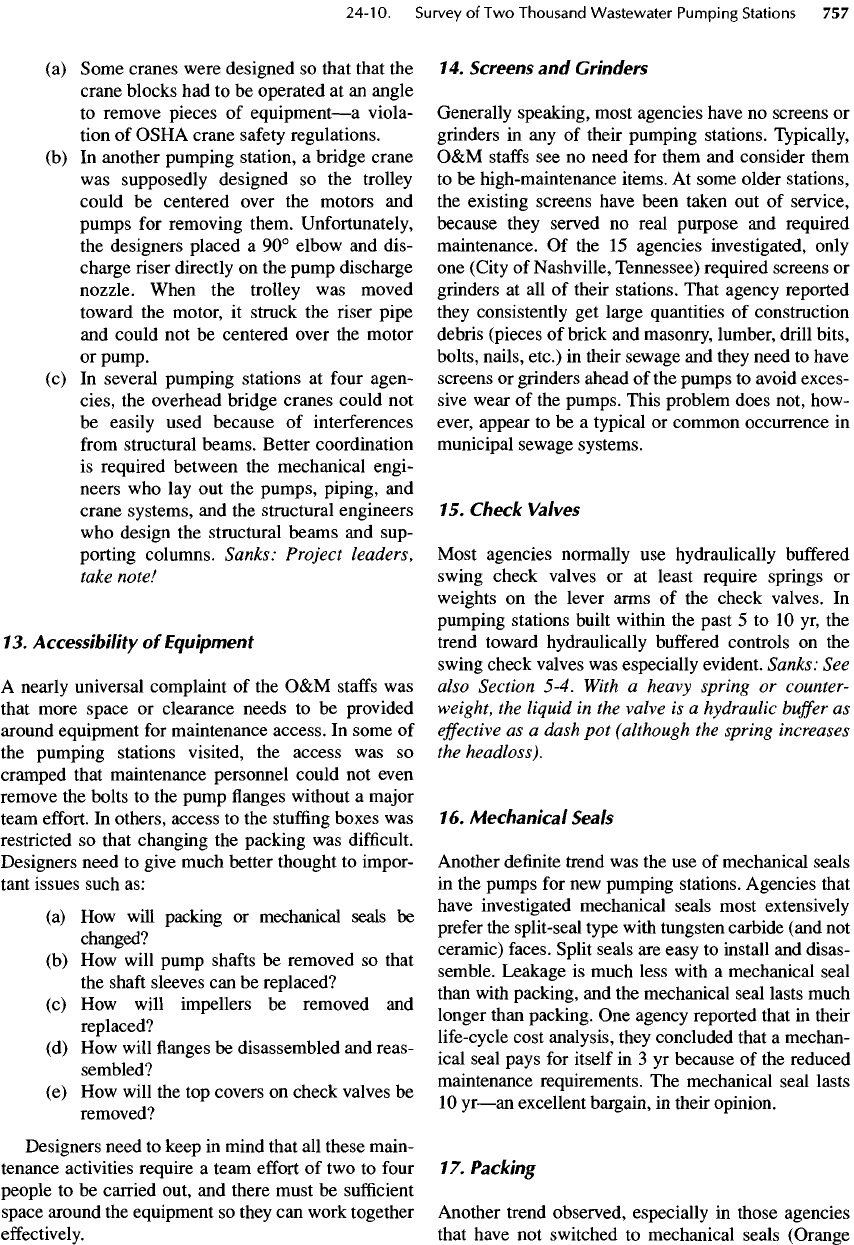
(a)
Some cranes were designed
so
that that
the
crane blocks
had to be
operated
at an
angle
to
remove
pieces
of
equipment
—
a
viola-
tion
of
OSHA crane
safety
regulations,
(b)
In
another pumping station,
a
bridge crane
was
supposedly designed
so the
trolley
could
be
centered over
the
motors
and
pumps
for
removing them. Unfortunately,
the
designers placed
a 90°
elbow
and
dis-
charge riser directly
on the
pump discharge
nozzle. When
the
trolley
was
moved
toward
the
motor,
it
struck
the
riser
pipe
and
could
not be
centered over
the
motor
or
pump.
(c) In
several pumping stations
at
four
agen-
cies,
the
overhead bridge cranes could
not
be
easily used because
of
interferences
from
structural beams. Better coordination
is
required between
the
mechanical engi-
neers
who lay out the
pumps, piping,
and
crane systems,
and the
structural engineers
who
design
the
structural beams
and
sup-
porting columns.
Sanks:
Project
leaders,
take
note!
13.
Accessibility
of
Equipment
A
nearly universal complaint
of the O&M
staffs
was
that more space
or
clearance needs
to be
provided
around
equipment
for
maintenance access.
In
some
of
the
pumping stations visited,
the
access
was so
cramped that maintenance
personnel
could
not
even
remove
the
bolts
to the
pump
flanges
without
a
major
team
effort.
In
others, access
to the
stuffing
boxes
was
restricted
so
that changing
the
packing
was
difficult.
Designers need
to
give much better thought
to
impor-
tant
issues such
as:
(a)
How
will packing
or
mechanical seals
be
changed?
(b) How
will pump
shafts
be
removed
so
that
the
shaft
sleeves
can be
replaced?
(c)
How
will impellers
be
removed
and
replaced?
(d)
How
will
flanges be
disassembled
and
reas-
sembled?
(e)
How
will
the top
covers
on
check valves
be
removed?
Designers need
to
keep
in
mind that
all
these main-
tenance activities require
a
team
effort
of two to
four
people
to be
carried out,
and
there must
be
sufficient
space around
the
equipment
so
they
can
work together
effectively.
14.
Screens
and
Grinders
Generally speaking, most agencies have
no
screens
or
grinders
in any of
their pumping stations. Typically,
O&M
staffs
see no
need
for
them
and
consider them
to
be
high-maintenance items.
At
some
older
stations,
the
existing screens have been taken
out of
service,
because
they served
no
real
purpose
and
required
maintenance.
Of the 15
agencies investigated, only
one
(City
of
Nashville, Tennessee) required screens
or
grinders
at all of
their stations. That agency reported
they
consistently
get
large quantities
of
construction
debris
(pieces
of
brick
and
masonry, lumber, drill bits,
bolts, nails, etc.)
in
their sewage
and
they need
to
have
screens
or
grinders ahead
of the
pumps
to
avoid exces-
sive wear
of the
pumps. This problem does not, how-
ever, appear
to be a
typical
or
common occurrence
in
municipal sewage systems.
15.
Check
Valves
Most agencies normally
use
hydraulically
buffered
swing check valves
or at
least require springs
or
weights
on the
lever arms
of the
check valves.
In
pumping
stations built within
the
past
5 to 10 yr, the
trend
toward hydraulically
buffered
controls
on the
swing
check valves
was
especially evident. Sanks:
See
also
Section
5-4.
With
a
heavy
spring
or
counter-
weight,
the
liquid
in the
valve
is a
hydraulic
buffer
as
effective
as a
dash
pot
(although
the
spring
increases
the
headloss).
16.
Mechanical
Seals
Another
definite
trend
was the use of
mechanical seals
in
the
pumps
for new
pumping stations. Agencies that
have
investigated mechanical seals most extensively
prefer
the
split-seal type with tungsten carbide (and
not
ceramic) faces. Split seals
are
easy
to
install
and
disas-
semble. Leakage
is
much less with
a
mechanical seal
than
with packing,
and the
mechanical seal lasts much
longer than packing.
One
agency
reported
that
in
their
life-cycle
cost analysis, they concluded that
a
mechan-
ical seal pays
for
itself
in 3 yr
because
of the
reduced
maintenance requirements.
The
mechanical seal lasts
10
yr
—
an
excellent bargain,
in
their opinion.
17.
Packing
Another trend observed, especially
in
those agencies
that have
not
switched
to
mechanical seals (Orange
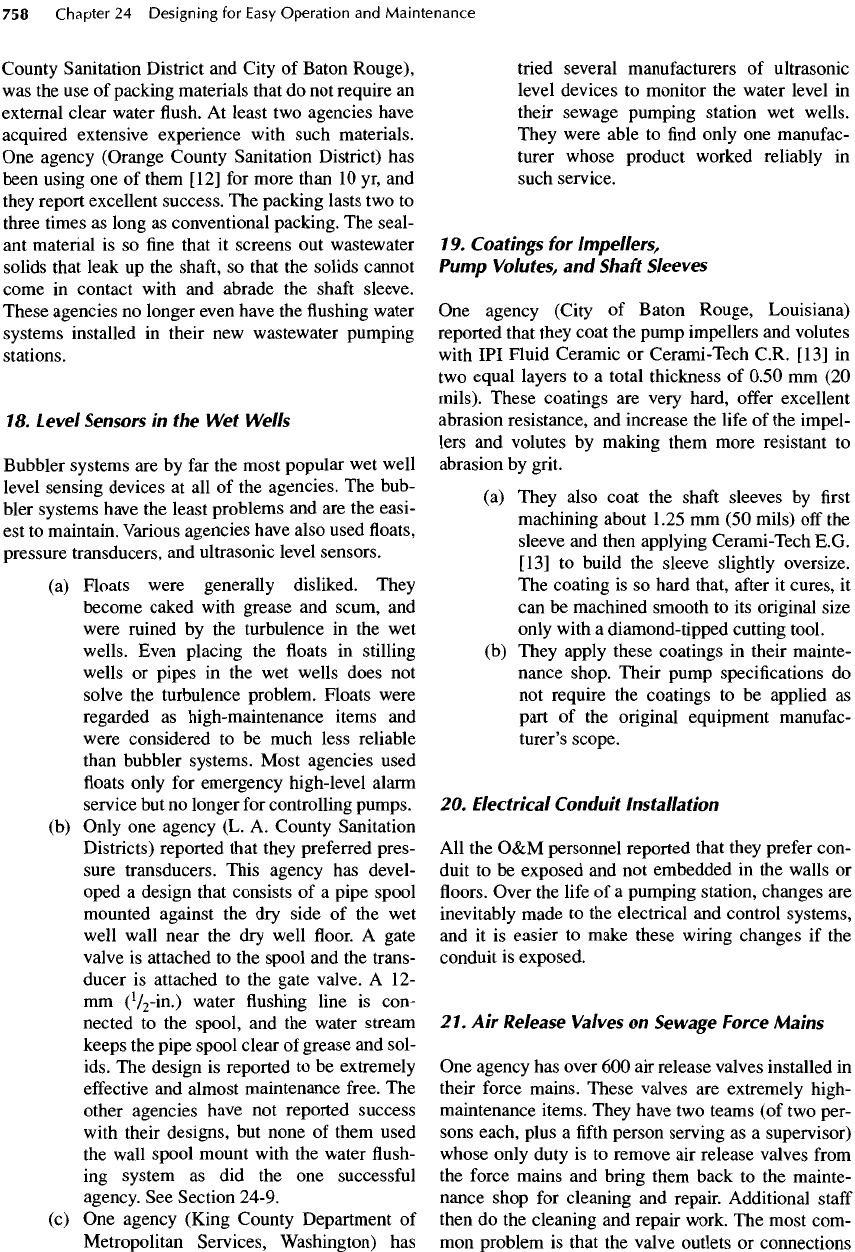
County Sanitation District
and
City
of
Baton Rouge),
was
the use of
packing materials that
do not
require
an
external
clear water
flush. At
least
two
agencies have
acquired extensive experience with such materials.
One
agency (Orange County Sanitation District)
has
been using
one of
them
[12]
for
more than
10
yr, and
they
report excellent success.
The
packing lasts
two to
three times
as
long
as
conventional packing.
The
seal-
ant
material
is so fine
that
it
screens
out
wastewater
solids that leak
up the
shaft,
so
that
the
solids cannot
come
in
contact with
and
abrade
the
shaft
sleeve.
These
agencies
no
longer
even have
the flushing
water
systems
installed
in
their
new
wastewater pumping
stations.
18.
Level
Sensors
in the Wet
Wells
Bubbler
systems
are by far the
most popular
wet
well
level sensing devices
at all of the
agencies.
The
bub-
bler systems have
the
least problems
and are the
easi-
est to
maintain. Various agencies have also used
floats,
pressure transducers,
and
ultrasonic level sensors.
(a)
Floats
were generally disliked. They
become caked with grease
and
scum,
and
were ruined
by the
turbulence
in the wet
wells.
Even placing
the floats in
stilling
wells
or
pipes
in the wet
wells does
not
solve
the
turbulence problem. Floats were
regarded
as
high-maintenance items
and
were considered
to be
much less reliable
than
bubbler systems. Most agencies used
floats
only
for
emergency high-level alarm
service
but no
longer
for
controlling
pumps,
(b)
Only
one
agency
(L. A.
County Sanitation
Districts)
reported that they preferred pres-
sure transducers. This agency
has
devel-
oped
a
design that consists
of a
pipe spool
mounted
against
the dry
side
of the wet
well
wall near
the dry
well
floor. A
gate
valve
is
attached
to the
spool
and the
trans-
ducer
is
attached
to the
gate valve.
A 12-
mm
(
l
/
2
-\n.)
water
flushing
line
is
con-
nected
to the
spool,
and the
water stream
keeps
the
pipe
spool
clear
of
grease
and
sol-
ids.
The
design
is
reported
to be
extremely
effective
and
almost maintenance
free.
The
other agencies have
not
reported success
with
their designs,
but
none
of
them used
the
wall spool mount
with
the
water
flush-
ing
system
as did the one
successful
agency.
See
Section 24-9.
(c)
One
agency (King County Department
of
Metropolitan Services, Washington)
has
tried
several
manufacturers
of
ultrasonic
level devices
to
monitor
the
water level
in
their sewage pumping station
wet
wells.
They were able
to find
only
one
manufac-
turer
whose product worked reliably
in
such
service.
19.
Coatings
for
Impellers,
Pump
Volutes,
and
Shaft
Sleeves
One
agency (City
of
Baton Rouge, Louisiana)
reported that they coat
the
pump impellers
and
volutes
with
IPI
Fluid Ceramic
or
Cerami-Tech C.R. [13]
in
two
equal layers
to a
total thickness
of
0.50
mm (20
mils).
These
coatings
are
very hard,
offer
excellent
abrasion resistance,
and
increase
the
life
of the
impel-
lers
and
volutes
by
making them more resistant
to
abrasion
by
grit.
(a)
They also coat
the
shaft
sleeves
by first
machining
about
1
.25
mm (50
mils)
off the
sleeve
and
then applying Cerami-Tech E.G.
[13]
to
build
the
sleeve slightly oversize.
The
coating
is so
hard that,
after
it
cures,
it
can
be
machined smooth
to its
original size
only
with
a
diamond-tipped cutting
tool,
(b)
They apply these coatings
in
their mainte-
nance shop. Their pump specifications
do
not
require
the
coatings
to be
applied
as
part
of the
original equipment
manufac-
turer's scope.
20.
Electrical
Conduit
Installation
All
the O&M
personnel reported that they prefer con-
duit
to be
exposed
and not
embedded
in the
walls
or
floors.
Over
the
life
of a
pumping station, changes
are
inevitably made
to the
electrical
and
control systems,
and
it is
easier
to
make these wiring changes
if the
conduit
is
exposed.
21.
Air
Release
Valves
on
Sewage
Force
Mains
One
agency
has
over
600 air
release valves installed
in
their force mains.
These
valves
are
extremely high-
maintenance items. They have
two
teams
(of two
per-
sons each, plus
a fifth
person serving
as a
supervisor)
whose
only
duty
is to
remove
air
release valves
from
the
force mains
and
bring them back
to the
mainte-
nance shop
for
cleaning
and
repair. Additional
staff
then
do the
cleaning
and
repair work.
The
most com-
mon
problem
is
that
the
valve outlets
or
connections
